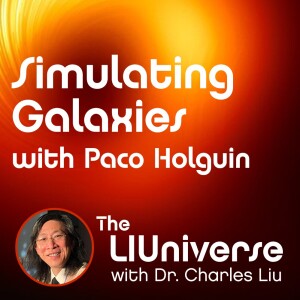
Saturday Apr 01, 2023
Simulating Galaxies with Paco Holguin
How can we create accurate models of galaxies, both ours and others? To find out, Dr. Charles Liu and co-host Allen Liu welcome Paco Holguin, a graduate researcher at the University of Michigan Dept. of Astronomy who specializes in computational astrophysics and galactic simulations.
As always, though, we start off with the day’s joyfully cool cosmic thing: neutron decay. The scientists at Los Alamos National Lab have recently determined that the half-life of a neutron is 877+/- 0.5 seconds, or about 14.5 minutes!
Moving on, Paco tells us how his love for video games and simulations led him to his field of studies, which includes the study of cosmic rays, charged particles and magnetic fields as he models galaxies. And of course, no discussion of Cosmic Rays can possibly pass without a discussion of the Fantastic Four, whose superpowers in the Marvel Comics derived from their exposure to cosmic rays.
For our first student question, Will from the Pingree School Astronomy Club wants to know about other extreme objects other than black holes and neutron stars in our galaxy. Paco starts by explaining how some types of cosmic rays, called ultra-high energy cosmic rays, qualify as extreme objects. Find out about the “Oh My God” particle, which moves so close to the speed of light that if it raced a photon across the galaxy, the photon would only be ahead by a meter after 300,000 years. (To avoid possible confusion, we’re not talking about the so-called “God Particle”, aka the Higgs boson.)
Paco explains how sometimes when he models a galaxy, it’s going along well and all of a sudden, it simply explodes. Because he uses extremely complex equations to simulate galaxies, Paco decided to take a graduate math class to better understand those equations.
Next up, Jayla from North Andover asks if there is an upper limit to the size of a black hole. As Paco and Charles discuss the possibility, agreeing that while we don’t know whether there is an actual upper limit, or we just haven’t found it yet, we have measured black holes that have billions of times the mass of our Sun.
Finally, Paco discusses what he’s been doing recently at Los Alamos, where for the past two summers he worked on machine learning projects with a diverse set of scientists and researchers. One of the projects he worked on was analyzing data from the Mars Curiosity Rover’s Chemcam using machine learning with mathematicians and computer scientists. Paco also shared with us that now that he’s finishing up his PhD, he’s off to the Applied Physics Lab at Johns Hopkins University to work on projects including exploratory space probe missions, national security issues, and more.
We hope you enjoy this episode of The LIUniverse, and, if you do, please support us on Patreon.
Credits for Images Used in this Episode:
Curiosity's Chemcam – Credit: NASA, Public Domain
Los Alamos National Labs, aerial view – Credit: Los Alamos National Labs
No comments yet. Be the first to say something!